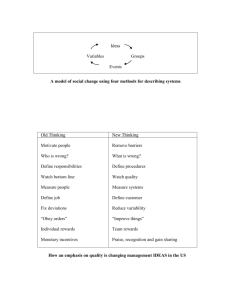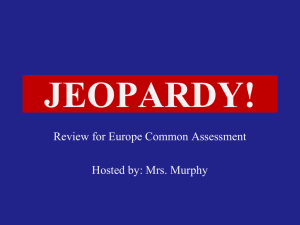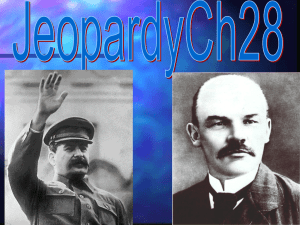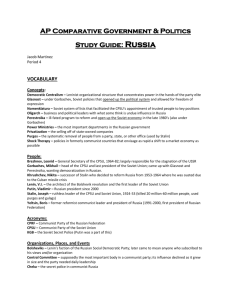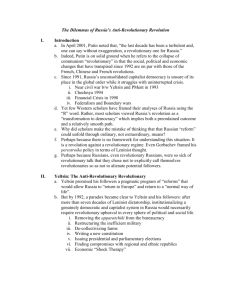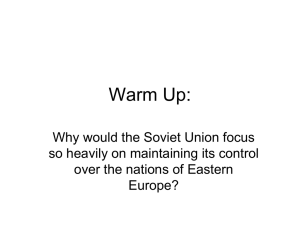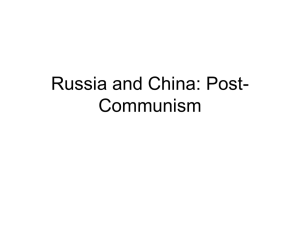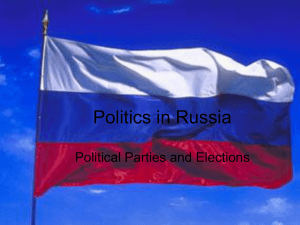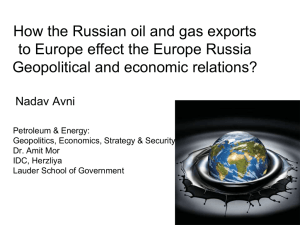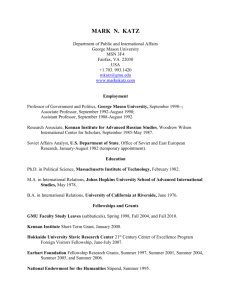File - AP Comparative Government
advertisement
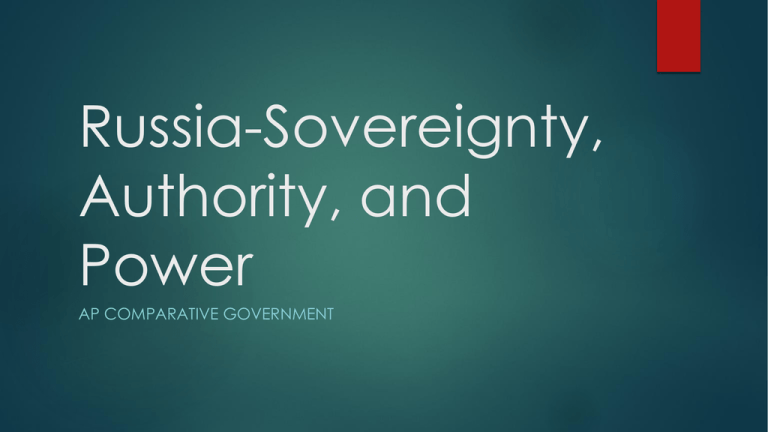
Russia-Sovereignty, Authority, and Power AP COMPARATIVE GOVERNMENT Fall and Rise From 1945 to 1991 the world’s political stages was dominated by the Soviet Union and the United States It was in 1991 when the Communist Russia suddenly collapsed The Russian Federation was formed after the Soviet Unions satellite nations broke away from the union Boris Yeltsin, a former member of the Soviet Politiburo, became the first president of the Russian Federation Presidential Yeltsin soon instituted massive reforms known as “shock therapy” These reforms pushed the Russian Federation towards democracy and a free market economy Yeltsin was often ill or drunk, and because of this his rule was uneven and at times authoritarian Because of his illness, his family took over the government and ran it similar to an oligarchy Political favors and economic and political corruption ensued In 1993 a constitution was instituted and free and fair elections followed Putin In 2000 and then again in 2004 Vladimir Putin was elected Putin aggressively sought to limit the power of the oligarchy established under Yeltsin’s regime Putin has also attempted to recentralize much of the power that was spread out after the fall of the Soviet Union Putin did step down after his two terms were over but has just been recently reelected as President of Russia after sitting out one term Sovereignty, Authority, and Power Historically, political legitimacy has been based on strong, autocratic rule. Early Russian history is dominated by tsars and then moves to the dictatorships of the 20th century For much of the 20th Century, political power centered in the Politburo of the communist party The individuals who were part of the Politburo climbed the ranks through nomenklatura, or an ordered path from local party soviets to the “commanding heights” of leadership Legitimacy Under communist rules, Marxism-Leninism provided the legitimacy base for the party The central idea to the Soviet Unions rule was Democratic centralism, or the rule of few for the benefit of the many. Stalinism was the reality of rule throughout Russia’s Communist history Stalinism revolved around totalitarianism Stalinism was centered on invasive policies built around the will of on strong leader In reality, the government under Stalin was not based on communism, but on totalitarianism The reforms of Nikita Khrushchev and Mikhail Gorbachev ultimately led to the downfall of the Soviet Union Both men tried to lessen the amount of power that the central government contained Legitimacy The Constitution of 1993 provided for a strong president The presidents power is checked by popular election and by the lower house of the legislature called the Duma The power of the constitution has been challenged a number of times Yeltsin’s oligarchy and conflict with the Duma Attempted coups Lack of faith from the people The power of the Constitution was solidified with the successful transition of power between Yeltsin and Putin Historical Influences on Political Traditions Absolute, Centralized Rule Russia has a long history of absolute and centralized rule. Large portions of Russia were conquered by the Huns, Vikings, and Mongols. Tsars lead Russia with complete control for centuries The 20th century was dominated by Communist rule Russia has a large amount of cultural heterogeneity The expansion of cultural heterogeneity was aided by the rapid expansion of territory controlled by Russia There are a large number of ethnicities and cultures that are all part of the Russian state Historical Influences on Political Traditions Slavophile v Westernizer There is a long history of division between western culture and Slavic culture Rulers such as Tsar Peter the Great and Catherine the Great took on western ideas that benefited the country, while still protecting Slavic roots and history For a large part of Russian history, they were very isolated from the west Tsar Peter the Great used a western model to modernize Russia and built a stronger army, navy, and infrastructure. He also built St. Petersburg to be a “window to the west” Revolutions of the 20th Century The autocratic rule of the Tsars ended in 1917 when the Bolshevik revolution took place This was the beginning of the implementation of a Communist form of government In 1991, the U.S.S.R. dissolved and 15 new independent nations were created from the fall of the government Political Culture Geographic Setting Russia is the largest country in the world and encompasses many different ethnicities and climates. One of the weaknesses of Russia through is their lack of access to a warm-water port. Russia does have access to many natural resources such as natural gas, oil, and timber. Russia’s geographic setting set them apart from the rest of Europe and influence their view of the Renaissance, Reformation, Scientific Revolution, and Enlightenment. Russian history is largely based on Statism, while western society is based upon strong civil society Equality of Result Under communist rule, the government valued equality of result rather than equality of opportunity. Under this ideology, everyone within society should be equal and this hinders the idea of capitalism Political Culture Skepticism about Power Russia has a history of being skeptical about government power This was displayed in strong fashion when Mikhail Gorbachev instituted the policy of glasnost Glasnost allowed for citizens to openly criticize the government for the first time under communist rule Recent polls have showed that citizens have little citizens have little trust in the government, but surprisingly has a very strong opinion about Vladimir Putin. This support has slipped from it’s 2008 high of 90%, but still hovers above 60% The Importance of Nationality Despite a long history cultural heterogeneity, people still tend to categorize others based upon their nationality and discriminate against group based on long-held sterotypes
